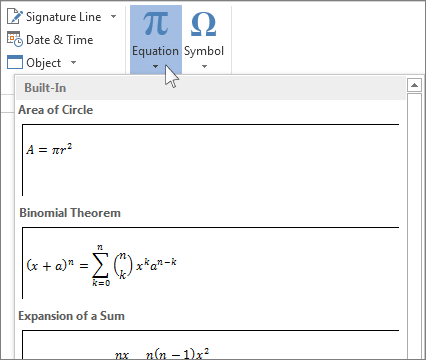Inserting an equationedit In Microsoft Word there are two different typing environments: text and math. To get a mathematical environment, click Equation on the ribbon that is inserted on Windows or Word for Mac '16, or '11 in the document elements on Word for Mac. Using the Equation Editor Inserting an Equation To insert an equation, do one of the following. Word: Insert / Object / Microsoft Equation 3.0 WordPerfect: Insert / Equation If you are using Word on your home computer, you may want to add the equation editor to the toolbar so that it is much quicker to add equations. To access the Equation Editor, hit Insert Object, choose Microsoft Equation 3.0. This brings up the toolbar. You can create an equation, which looks a lot like a graphic in your document. To edit the equation later, just double-click it. To create another, you can copy the first one, and paste it, then double-click it to change it. The Formula popup in Word 16. Under Formula, Word takes a guess as to the formula you might want to use and displays ‘=SUM(LEFT)’. Unfortunately, this formula would simply add all the numbers.
Typing math symbols into Word can be tedious.
Thankfully, there is a faster way.
Dot Product In Microsoft Word Equation Generator
The default way of doing it is to use the Insert > Symbols > More Symbols dialog, where you can hunt for the symbol you want.
Finding the actual symbol you want takes a lot of paging through the character map, which is not fun.
It’s easier if you’re in Word’s equation editor / math mode (Alt + = enters math mode), where you can just type symbol names like omega and times. LaTeX users are already familiar with this method, and the syntax is similar.
Math mode can be overkill for simple symbols and formulas. An easier way to type symbols into normal Word paragraphs is to enable the “Use Math AutoCorrect rules outside of math regions” option:

Once you have enabled this option, you can type things like:
Some useful symbols are:
| δ | `delta` (also `alpha`, `beta`, etc.) |
| Δ | `Delta` (note uppercase D for uppercase delta symbol) |
| × | `times` |
| ÷ | `div` |
| ± | `pm` (plus/minus) |
| ∞ | `infty` |
| ≠ | `neq` (not equal to) |
| ≥ | `geq` (greater or equal to) |
| ≤ | `leq` (less or equal to) |
| ° | `degree` |
| → | `rightarrow` |
| ⇒ | `Rightarrow` |
The advantage of this method, versus the full-blown equation editor, is that the symbols and equations typed this way are no different to ordinary text. This means they can be copied and pasted into other applications, including Excel, PowerPoint, internet pages, and humble text editors, without loss of fidelity.
Cached
In contrast, copy pasting Equation Editor equations into other applications like Excel or PowerPoint doesn’t work. I have also had strange interactions between Track Changes and the Equation Editor, so I avoid the Equation Editor where possible.
Dot Product In Microsoft Word Equation Template

It’s also useful to know that Ctrl + = toggles subscript mode (Pmax), and Ctrl + Shift + = toggles superscript mode (x2 = y2 + z2). This can be used to type equations like the below.